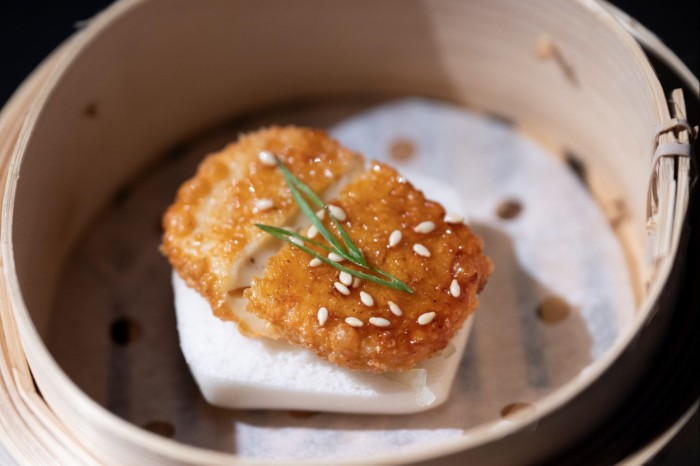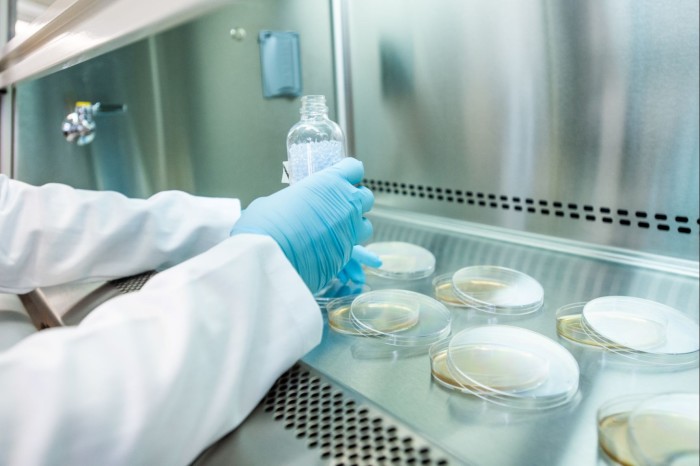[ad_1]
Every Thursday night, at an invitation-only event in an upscale Singapore hotel, a small group enjoys a four-course dinner while watching videos about an unfolding environmental crisis.
Menus in the dimly lit room at the JW Marriott are designed to highlight the environmentally destructive impact of industrial cropping and livestock breeding.
Corn is served three ways to evoke deforestation, while a dashi broth is poured over colourful vegetables and seaweed to represent rising sea levels.
Then comes the main dish: chicken nuggets, served with maple waffles and a Chinese-style bao bun. Guests put down their wine glasses, slice the meat carefully into bite-sized pieces and linger on the taste.
The ceremony is a sign that the nuggets are far more than standard fast-food fare: no chicken died to make them. They were created from stem cells, made by a US start-up and, so far, available only in Singapore.
Silicon Valley foodtech unicorn Eat Just is selling its meat in the world’s only nation to have approved the commercialisation of lab-cultivated chicken.
The Marriott meal is an early taste of a food technology revolution whose advocates say could feed Asia’s fast-growing population, curb damage to the planet and eventually cost less than traditional meat.
“We could theoretically grow anything that might come from plants or animals, from cells instead,” Isha Datar, executive director of cellular agriculture research institute New Harvest, said in a talk.
Food inflation in Asia, where more than 1.1bn people lacked access to adequate food last year, is hovering near its all-time high and not expected to ease any time soon.
The region’s population is projected to increase by 700mn in the next three decades. Widening income gaps, supply chain disruptions and extreme climate conditions are causing price surges and accelerating a food security crisis long in the making.

Asia is home to ideas still in early stages of research but potentially transformative in feeding more people, with fewer resources, in the decades to come. Innovations such as lab-grown meat and 3D-printed food are at the forefront of efforts to rethink how, and what, we can feed the region’s next billion.
By 2030 alone, Asia is expected to add 250mn people to its current population of 4.6bn.
By then, meat consumption will increase 18 per cent, but agricultural production will grow only 2 per cent or less, according to a joint report by the UN’s Food and Agriculture Organization and the OECD.
Around 65 per cent of the world’s middle class will be living in the region by 2030, according to a report by PwC, Temasek and Rabobank. Total spending on food in Asia is expected to double to $8tn, the report said, adding that “Asia is unable to feed itself”.

The numbers are opportune for investors with deep pockets and big ambitions. Temasek, a Singapore state-owned investor, has said traditional food solutions can “no longer meet the world’s demands”. It has committed more than $8bn to foodtech since 2013.
Some of that has been poured into Eat Just, which has also received funding from Mitsui & Co and Khosla Ventures, as well as private investors such as Yahoo co-founder Jerry Yang and Salesforce co-founder Marc Benioff.
In the video: Eat Just’s chicken nugget is served at Loo’s Hainanese Curry Rice in Singapore
Valued north of a billion dollars, the company has raised more than $800mn so far. And as food prices have soared, it has received more attention from investors. “In the last three months, I got more phone calls, more emails, more direct messages, more introductions, more interest than I ever had at any time,” Josh Tetrick, co-founder of Eat Just, told Nikkei Asia last month.
On a sunny Singapore afternoon last autumn, in the trendy heritage neighbourhood of Tiong Bahru known for its famed hawker centre, Loo Kia Chee received a phone call. It was someone from Eat Just offering a limited-time collaboration with its cultivated meat division GOOD Meat, to serve up their nuggets with his curry.

“I was surprised,” Loo recalls. “I was the first one to get picked for doing this in Asia or the whole world,” and “before that, I didn’t know about the cultivated meat”.
This spring, Loo made history by becoming the world’s first hawker stall to serve lab-made chicken. Customers flocked to Loo’s Hainanese Curry Rice, his popular lunchtime haunt, for the novel treat.
Loo said he thought it tasted “like normal chicken . . . [and the similarity to conventional chicken is] I think 98 per cent”.

Asked if he might make the cultivated meat his signature dish some day, Loo seemed receptive to the idea. “If the price challenges [that of conventional meat],” he said, “I will use it.”
Animal agriculture in the Asia-Pacific region is responsible for 14.5 per cent of global warming, according to the FAO — more than the transportation sector. It also consumes a significant portion of the region’s land and water.
Globally, more than 70bn land animals and 1tn fish are killed each year for food.
Advocates for food technology argue it could play a crucial role in easing these problems.
“Foodtech has the potential to . . . reduce the pressure on land usage from crop and animal agriculture, reduce water consumption, increase yields to meet demands without resource limitation and improve the nutritional profile of products,” said Gautam Godhwani, managing partner of Good Startup, which invests in alternative protein companies.
Eat Just is among the pioneers of these technologies.
Lab-grown chicken is created from cells from a biopsy, an egg or even a feather.

The meat grows as the cells multiply in a stainless steel tank called a bioreactor. They feed on a broth that contains nutrients like carbohydrates, amino acids, minerals, fats and vitamins. “Instead of growing the entire animal, we only grow what is eaten,” Eat Just said in a statement.
“This means we use fewer resources . . . completing growth in weeks rather than months or years. Then, the harvested product can be used by chefs in multiple final formats, from less structured crispy chicken nugget bites, savoury chorizo and sausages, to more textured products such as shredded chicken or grilled chicken breast.”
Eat Just has offered to consumers iterations aside from the nugget, including satay, or grilled chicken skewers.
Still, these remain early days for the industry. Even foodies in Singapore, the world’s only country to approve the sale of lab-grown meat, will have to wait a few years until Eat Just’s meat is readily available at the city-state’s famed street-food hawker stalls.
Eat Just’s samples are available through invitation-only events, pop-up tastings and limited offers of food delivery.
A Nikkei Asia reporter invited to the Marriott tasting in Singapore said the nuggets differed only slightly from traditional meat in that they were “unnaturally smooth” while also being softer and less chewy. He said the satay, served up for the first time in May, looked and tasted even closer to traditional chicken than the nuggets.

“A very concrete goal of our company is to, in our lifetime, have a system where the majority of meat doesn’t require slaughter and deforestation,” said Tetrick, best known in the US for commercialising a liquid “egg” product made from protein-rich mung beans.
His company is also working on beef. The red meat is the top driver of deforestation, according to conservation organisation WWF, causing more than double the forest conversion generated by the next more damaging crops such as soy, palm oil and wood.
Meat production is moving out of abattoirs and into laboratories.
Currently producing less than 1,000kg of cultivated chicken a year, Eat Just is planning a new facility in Singapore that will help scale to tens of thousands of kilogrammes annually, Tetrick said.
The company expects to achieve cost parity with conventional meat, or become even cheaper, this decade.
Any research funded and developed in Singapore could be scaled up to help feed the rest of Asia, where a fast-growing population is coping with rising rates of hunger and malnourishment in the face of surging food prices.
More than 489mn people in Asia were severely food insecure last year, meaning that they had run out of provisions. That is an increase of 112.3mn people in two years in this region alone.

Food prices are expected to keep rising not only in Singapore, but across the region, making self-reliance the latest buzzword.
It is no accident that Singapore is among the first to embrace cultured meat.
Long popular for its gastronomy, the city-state has scarce farming land and imports more than 90 per cent of its food.

Hit by its highest food inflation rate since 2012, the small island nation aims to produce 30 per cent of its nutritional needs by 2030. Given that only 1 per cent of its land is used for conventional farming, the metropolis has decided to invest heavily in technology-based approaches.
Alternative proteins, including lab-cultivated meat, today account for 2 per cent of the global meat market. But they could reach 11 per cent, or $290bn, by 2035, according to a joint report by Boston Consulting Group and Blue Horizon.
“By 2035, every tenth portion of meat, eggs and dairy eaten around the globe is very likely to be alternative. And this is a pretty conservative scenario,” according to Boston Consulting Group and Blue Horizon.

Achieving parity with animal proteins on taste, texture and, most importantly, price, is a tall order, but one the joint report said is plausible in the next 10 years.
Some industry groups have dismissed the forecast as too optimistic, given people’s attachment to traditional meats and the nascency of the technology.
“It requires a lot of capital,” Eat Just’s Tetrick said. “It requires investors to understand that there’s risk associated with that capital and investors who realise that there’s an opportunity for very high return, and also there is meaning in going after an urgent problem.”
Investors are listening. Foodtech — ranging from lab-grown meat to indoor urban farms — received a record $12.8bn in venture investment last year, double the amount a year earlier, according to Crunchbase.
Nearly half of that went to companies creating alternatives to traditionally produced meat, seafood and dairy products.
RethinkX is an independent think-tank that analyses the speed and scale of technology-driven disruption and its implications across society.
Foodtech advocates emphasise that the dietary changes required are neither as radical, nor repellent, as critics claim. For example, we can still consume dairy but will not have to do it directly from animals. In other words, we could have our buttery cake and eat it, too.

Biotech start-up TurtleTree creates milk components from cells. Like Eat Just, the company operates in both California and Singapore — a popular arrangement that allows foodtech businesses access to Silicon Valley capital and the Asian city’s regulatory support.
By encouraging host cells to produce milk ingredients in bioreactors, TurtleTree hopes eventually to create dairy offshoots such as cream, cheese and butter. Precision fermentation allows humans to programme micro-organisms to produce almost any complex organic molecule.
Citing higher production efficiency and more environmentally friendly processing than the traditional $800bn global dairy industry, cell-based milk is quickly amassing investor interest from the private and public sectors.

TurtleTree, which has raised nearly $40mn since its launch in 2019, plans to commercialise its cell-cultured milk ingredients in the near future. It is now working on lowering the cost of producing lactoferrin, a protein known to benefit gut health and support the immune system.
Lactoferrin from cattle is costly, with market prices fluctuating between several hundred dollars to $2,000 per kilogramme. This means the protein is deployed only in specialised areas such as infant nutrition, leaving broader uses like everyday food and adult nutrition untapped.
“Our goal is to develop this functional protein sustainably and eventually cost-efficiently . . . which will enable everyone to enjoy the benefits of lactoferrin through everyday nutrition,” said Lin Fengru, TurtleTree co-founder and chief executive.

“It is exciting to envision a future where these [dairy] bioreactors could be dropped anywhere in the world where there was a crisis or need for food,” said Fengru.
Investors are excited, too. Good Startup has bought stakes in both TurtleTree and Eat Just. Godhwani forecasts that increasing competition among foodtech businesses will further speed up innovation.
“The whole of the cow milk industry . . . will start to collapse once modern food technologies have replaced the proteins in a bottle of milk — just 3.3 per cent of its content,” executives at the think-tank RethinkX said in a report.

But experts are divided on whether foodtech can make a dent in the traditional meat market.
Others are less sceptical, citing the influence of demographic changes. “In 2050, the generation after Gen Z will be the main group of consumers. They will be environmentally conscious, so consumption trends will probably be very different from now,” said Seiichi Kizuki, research director at Mitsubishi Research Institute.
“One of our test models suggests that the foodtech industry will grow into a ¥279tn [$2tn] market by 2050. Meat substitutes will possibly have the biggest share.”
Kizuki did warn that high production costs were a bottleneck. “How to reduce costs, and be able to provide high-quality, safe food will be key,” he said.
Back in Singapore, Shiok Meats co-founders Sandhya Sriram and Ka Yi Ling are developing lab-cultivated seafood they hope will hit shelves in 2023.
“Many thought Ka Yi and I were crazy for leaving behind well-paid jobs to do this,” Sriram told Nikkei Asia at a meeting in Tokyo. Even though both were accomplished stem cell biologists, raising capital for the world’s first company to work on cell-based crustaceans was challenging without a male co-founder in a venture capital world notorious for its sexism.
Still, within six months of its founding in 2018, Shiok Meats raised about $5mn and launched its prototype: eight shrimp dumplings that cost $5,000 to make.
Since then, Shiok has raised more than $30mn, with backers including Japanese packaging maker Toyo Seikan Group Holdings, South Korean food delivery platform Woowa Brothers and Vietnamese seafood exporter Vinh Hoan Corporation.
A kilogramme of Shiok shrimp now costs $50, significantly lower than four years ago but still sharply higher than the market price of roughly $11 for traditional frozen shrimp in Singapore.
Sriram, a high-octane 36-year-old of Indian descent, said she was stirred by the world’s first lab-grown burger patty in 2013. “I was inspired to develop the technology in Asia with seafood, the most-loved protein in this part of the world,” she said, adding that cost parity is a goal but will take time.
Last year, the alternative protein company bought a 90 per cent stake in Gaia Foods, which uses stem cell technology to produce red meat in a laboratory. This added cell-based pork, beef and mutton to Shiok’s portfolio of shrimp, lobster and crab.

Shiok is targeting Malaysia, Indonesia, Japan, South Korea, China, Taiwan and Hong Kong, subject to regulatory approvals. Sriram also said she hoped Singapore would inspire foodtech policy in India, the country of her heritage and one that accounts for a quarter of the world’s food-insecure population.
“Growing up as a vegetarian because of ethical boundaries, I never imagined we would be able to opt for cruelty-free, sustainable seafood,” said Sriram, who hopes her 8-year-old son will grow up in a world where fewer animals would have to be killed for food.
In the video: Shiok samples its lab-cultivated lobster in gazpacho and terrine, and its lab-grown shrimp in beet spheres
From beautiful desserts to marbled steak, foodtech pioneers are also experimenting with 3D-printed food.
3D printing is a process in which materials are added layer by layer in a controlled, sequential manner to build up geometrically complex objects. Typically, food grade syringes hold the printing material, which is then deposited through nozzles.
Customising ingredients allows the tailoring of flavour, texture, colour, portion size, nutrients, calories and digestibility. One researcher gave the example of a vending machine in a gym that could use data obtained during exercise to make a personalised nutrition bar.

Shanghai-based agriculture start-up CellX is using advanced 3D-printing technology to create meat in a laboratory.
The potential is immense in the world’s most populous nation, and one with a voracious appetite for pork. CellX makes its version by harvesting cells from native black pigs.
The company, which has raised $15mn since its founding in 2020, is also working on beef and poultry.

“Cellular agriculture uses significantly fewer resources and emits less carbon,” said Ziliang Yang, co-founder and chief executive of CellX.
China this year introduced lab-grown meat and alternative proteins to its five-year agricultural development plan.
“We need to expand from traditional crops, livestock and poultry to more diverse biological resources, develop biotechnology, the bio-industry and get the proteins, calories from plants, animals and microorganisms,” President Xi Jinping said.

China’s food safety agency has been cautious about approvals, though. It is waiting for more studies and watching how things unfold as more countries approve the sale of lab-cultivated meat.
Other challenges include scale, cost, market education and consumer acceptance.
CellX has managed to cut the price of culturing cells by more than 90 per cent in the past two years.
In Hong Kong, Alt Farm is developing a 3D-printed prototype of plant-based A5 Wagyu, which is the highest grade awarded by the Japanese system based on colour, marbling, brightness, firmness, texture of meat and quality of fat.
Founders Joanna Hui and Kenny Fung teamed up at the Hong Kong University of Science and Technology in 2019 to develop a patented nozzle that generates fibrous textures for plant-based meat products.
“Our first target is to make plant-based products, but the technology allows us to adjust the 3D-printed food to be most textures from chewy to crunchy and so on,” Fung said. “The plant-based market is our first target as it is growing really fast and has the scale and innovation to support our simultaneous growth as well.”
Alt Farm will use a blend of pea, soy and algae protein for the “Wagyu”. The protein will be printed with fats and flavourings to re-create one of the world’s most expensive cuts of meat. Coconut, shea and cocoa butter will replicate the famous marbling. An initial prototype is slated for 2023.
Today, food printers are used commercially only in gourmet dining, molecular gastronomy restaurants and ambitious bakeries.
“3D-food printing along with cellular agriculture holds great promise in relieving the pressure on industrial farming to meet the global food demand,” Nadiah Ghazalli, consultant for chemicals, materials and nutrition at US researcher Frost and Sullivan, told Nikkei.
“We are still at a proof-of-concept stage, and much of it is targeted for specific uses such as texture enhancement,” she noted.

The degree of control allows for high levels of customisation, paving the way for personalised nutrition in industries with the most imminent need, such as hospitals, senior-care facilities and hospices.
Scientists at Nanyang Technological University in Singapore are working on 3D-printed soft food to help people who struggle to process solid food.
“It’s all meat [cooked chicken paste],” said Anirudh Agarwal, a research associate working on the technology. “We are also trying to make sure that . . . the ingredients being used have fibres that are proven to show some improvement in the digestive tract.”
Another dimension of the foodtech revolution is the war on waste.
Roughly a third of food is thrown away, according to the UN Environment Programme, because of shortcomings in production, distribution and, most importantly, storage.
In China alone, enough food to feed 200mn people is squandered annually, UNEP estimates.
This also means producers have to raise prices to compensate for their unsold stock.

A few years ago, when Masayuki Kinoshita was enjoying fresh mangosteen on the streets of a small village in Thailand, it was these concerns that led to an epiphany.
The Japanese entrepreneur spent the following weeks obsessing over how to import the fruit into his home country without losing its taste. At the same time, he was also troubled by the fact that Thais discarded massive amounts of fresh fruit because of a lack of storage options.
Frozen food degrades because of ice crystals that expand during cold storage. These can damage a product’s quality by causing the walls of its cells to rupture.
Kinoshita’s answer was to found Daybreak in 2013. The company uses advanced flash-freezing technology to minimise ice crystal formation. Its freezers can frost fish to its core in about an hour, Kinoshita told Nikkei Asia, compared with the seven hours it can otherwise take. Then the fish can be stored at optimal quality for about two months, compared with two or three weeks otherwise.
Clients use Daybreak’s speciality freezers for everything from fish to fruit.
Daybreak’s technology can flash-freeze fruit and store it for up to three years at optimal quality.
The company is now working on ramen and sushi.

This article is from Nikkei Asia, a global publication with a uniquely Asian perspective on politics, the economy, business and international affairs. Our own correspondents and outside commentators from around the world share their views on Asia, while our Asia300 section provides in-depth coverage of 300 of the biggest and fastest-growing listed companies from 11 economies outside Japan.
Subscribe | Group subscriptions
“We talk about food waste in the context that it is not good and it has to be stopped for our future. But in addition to that is the fact that this waste is hurting food producers,” Kinoshita told Nikkei Asia. “Producers cannot survive if they can’t sell their products [quickly] and cannot earn a living in this low-margin, high-turnover system.”
The idea that new technologies could save humanity from itself has become a trope of radical solutions to problems from global heating to overpopulation. But the food science revolution has a practicality and immediacy missing in ideas such as building colonies on Mars. If it succeeds, it could change a culture of eating perhaps as profoundly as when humanity shifted from hunter-gathering to settled farming.
“We ultimately want it to be at or below the cost of conventional meat,” Eat Just’s Tetrick said. “We’ve got to invest in infrastructure, the bioreactor, engineering, to make it at that scale.”
“In the next 40 years or so, I’d like to know that the majority of the meat consumed on the planet . . . doesn’t require the slaughter of animals,” the 42-year-old said. “I think within my lifetime, we can turn the corner on it and then pass the baton to the next generation for them to finish the job.”
A version of this article was first published by Nikkei Asia on July 23. ©2022 Nikkei Inc. All rights reserved.
Related stories
[ad_2]
Source link



